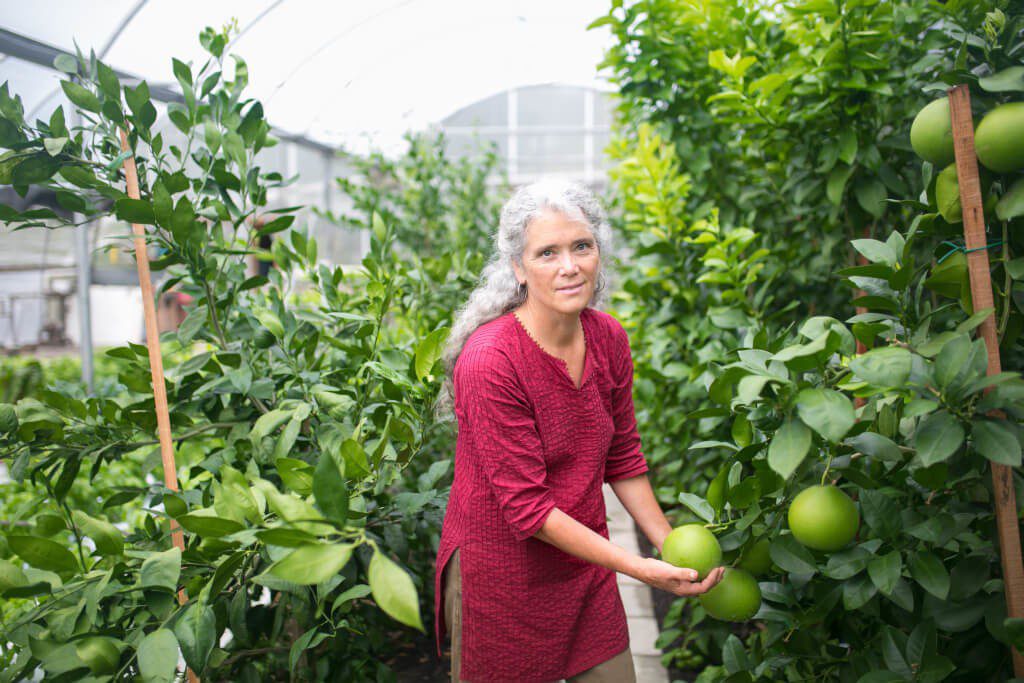Unique 6,000 sq. ft. greenhouse with hyperadobe heat storage wall, high efficiency wood gasifier furnace and water storage cistern, experimental anaerobic digester, rainwater harvesting, commercial hydroponic lettuce production and subtropical fruit production.
Concept
Jane Squier is a horticulturist interested in appropriate technology and organic growing, and has been a commercial hydroponic lettuce producer for thirty years. Her production methods are experimental, seeking to close the nutrient loops on her property.
Greenhouse and hyperadobe wall
The triple arch steel frame greenhouse was used only for hydroponic lettuce and basil for many years. A combination of factors led Jane to downsize the commercial production. Now two-thirds of the space is a semi-tropical orchard. Subsoil excavated for the fruit trees was shoveled into 25 ft mesh tubes and tamped into place creating a beautiful curved wall that absorbs heat, helps stabilize greenhouse temperatures, and moderates humidity levels.
Hydroponic lettuces and basil
Plants are grown in 100 ft lengths of standard eavestrough. Nutrient Film Technology is used to provide a continuous flow of nutrients—a combination of organic digestate and chemical fertilizers. Harvesting is automated and a new crop can be planted immediately, maximizing the amount of produce that can be grown while minimizing water use and waste.
Subtropical fruit
The experimental semi-tropical orchard consists of over 50 trees including semi-dwarf citrus, avocados, guava, jujube and pomegranate. Jane is harvesting various fruit including grapefruit,mandarins, oranges and avocados.
Rainwater harvesting
Rainwater from the greenhouse roof is collected in three large tanks— repurposed and reinforced above-ground swimming pools. The water is pumped to the greenhouse and filtered before being used. The hydroponic system recycles water and nutrients and isvery water efficient. Without the rainwater harvesting, water would have to be purchased and trucked in since groundwater is limited in this part of the island.
Rainwater from the metal roofs on the house and workshop is collected, filtered and UV treated for drinking water.
Anaerobic digester
A small custom-built biogas digester was installed five years ago. It converts kitchen and greenhouse waste to bio-available digestate and biogas. The digestate is pasteurized and used as liquid plant food. The biogas is used for cooking and for raising CO2 levels in the greenhouse.
Wood gasifier boiler
The greenhouse was originally heated with oil. Firewood has replaced the oil and the firewood required is harvested from the property. The outdoor wood gasifier has an efficiency rating of 90% and creates very little smoke. The high performance is achieved by heating the wood sufficiently to create “ wood gas” which is burned in the combustion chamber. Water heated in the furnace is pumped to the greenhouse. From there, a distribution system circulates the hot water to the different zones in the greenhouse as needed. Excess heat is captured and stored in an insulated 4,400 gal tank and is circulated on demand, increasing the burn time and efficiency of the furnace.
Forr more information: https://transitionsaltspring.com/jane-squiers-super-efficient-greenhouse-saves-time-and-energy/
Jane Squier, The Garden
(Salt Spring Living Lettuce)
(250) 537-5467
Wood gasifier
Polar Furnace, Neil Robb,
topline@mymts.net
Biogas digester
Off-Grid Gas and Fertilizers, Kealan Gell
kealan@offgridgas.org

